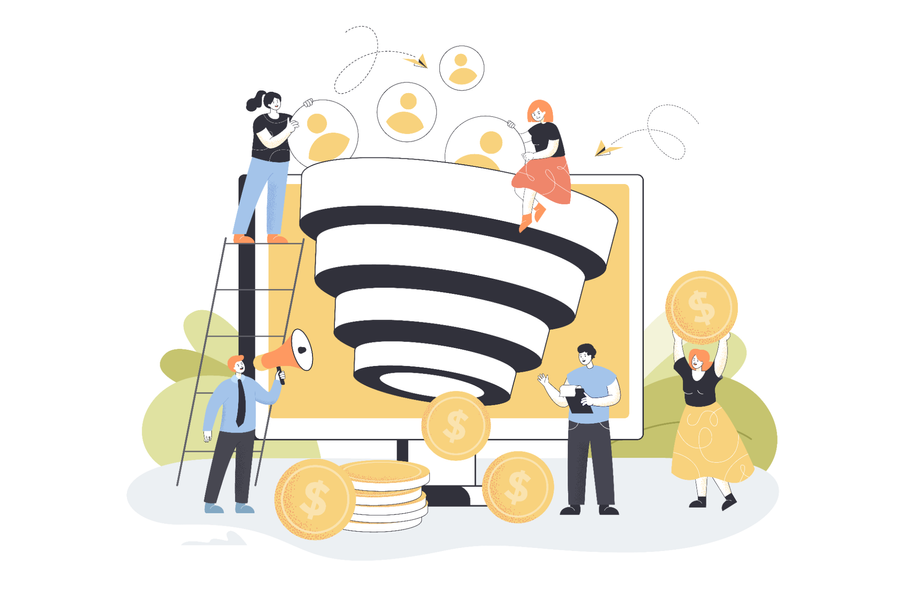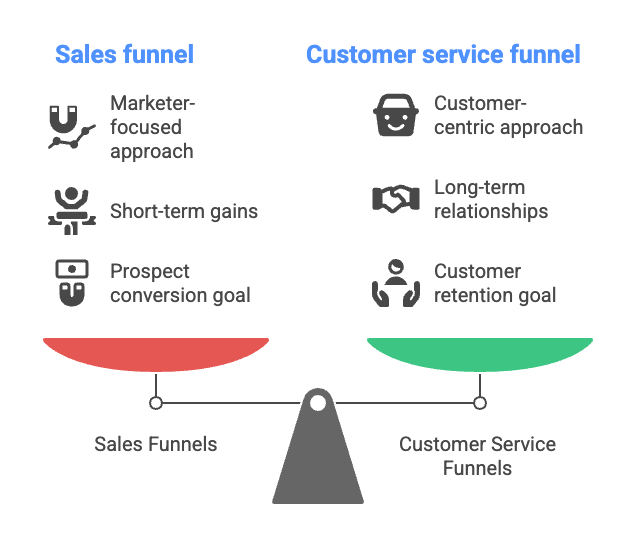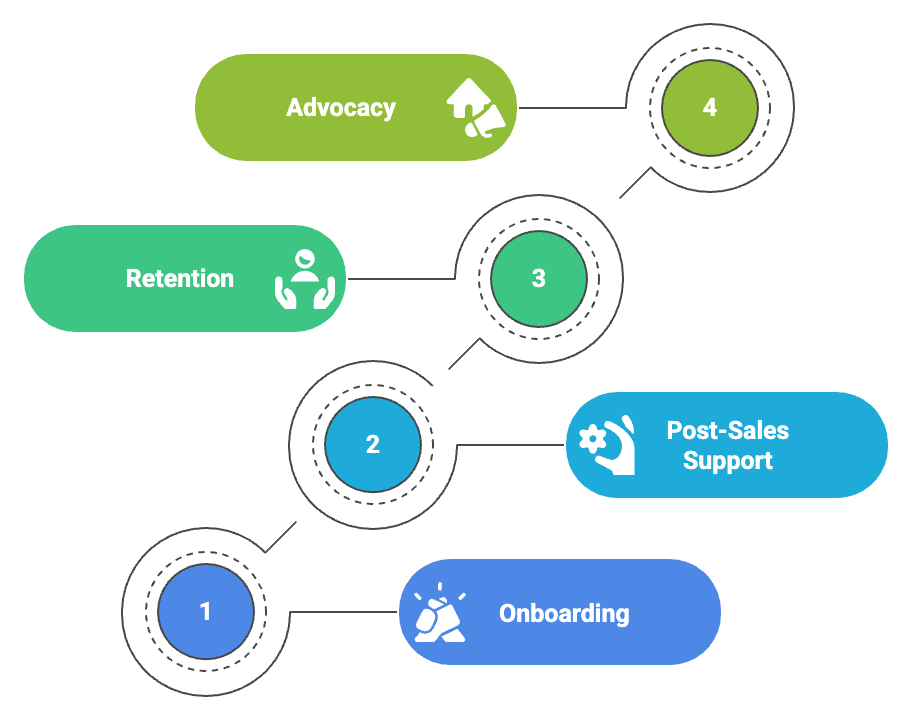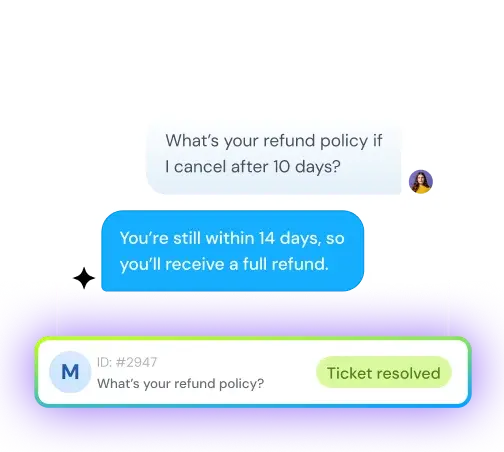What is a customer service funnel? A simple guide for growing businesses
Vaishali Jayaprakash
Aug 25, 2025

A Customer Service Funnel might just be your business's secret weapon for growth. The numbers tell an interesting story - getting new customers costs five times more than keeping your current ones. Customer service goes beyond problem-solving. It's a strategic way to build relationships throughout your customer's experience. The modern customer places high value on experience - about 80% say it matters just as much as the actual product or service. Many growing businesses put their energy into sales but overlook the well-laid-out support system that keeps customers loyal.
Your customer support funnel guides people from their first brand interaction to becoming loyal promoters. Growing businesses need to know that a well-managed customer experience funnel makes customers more likely to recommend your company when they rate your service as "good".
In this piece, you'll find what makes a customer service funnel tick, how it's different from a sales funnel, and practical steps to turn casual buyers into dedicated fans.
What is a customer service funnel
A customer service funnel shows the path your customers take after they buy your product or service. This framework doesn't end with a sale like traditional funnels do. Instead, it looks at what happens from the original onboarding right through to when customers become brand champions. You can think of it as a way to build stronger customer relationships after they've bought from you.
The customer support funnel has four main stages: onboarding, post-sales support, retention, and advocacy. Each stage needs its own support approach based on where customers are in their relationship with your brand.
How it is different from a sales funnel
Sales funnels and customer service funnels work together but serve different purposes. Sales funnels focus on turning prospects into customers through awareness, discovery, intent, and purchase. The sales funnel's work ends once a sale happens.
The customer service funnel starts right where the sales funnel stops. This creates what experts often call a "complete customer experience hourglass". Here are the main differences between these funnels:

Where it fits in the customer journey
Today's buying process isn't simple anymore. Studies show B2B customers need 7 to 13 touchpoints before buying (and around eight touchpoints in B2C). So understanding the whole customer journey is vital to business success.
A customer journey map shows every interaction between customers and your brand—from first awareness to brand loyalty. The customer service funnel handles everything that happens after purchase.
This funnel bridges pre-purchase and post-purchase experiences. It makes sure you take care of customer relationships properly at every stage, not just during the sale.
Why it matters for growing businesses
Growing businesses need a well-laid-out customer service funnel. A good customer support funnel offers three big advantages:
It keeps more customers around. When you match your support to what customers need at different stages, they stay happier and stick around longer.
It creates better conversations. You can spot and fix issues before customers need to reach out because you know where they are in their journey.
It gets people talking about you. Customers who say a company's service is "good" recommend that company 38% more often. Happy customers become free marketers who bring in new business naturally.
A well-run customer service funnel turns one-time buyers into loyal fans. These customers keep coming back and tell others about your brand too.
4 Key benefits of a customer support funnel
A resilient customer support funnel brings clear benefits that affect your bottom line. Your growing business gains many advantages from a well-laid-out support funnel that goes beyond just solving problems.
1. Improves customer retention
The numbers make a strong case for keeping customers. From a business viewpoint, getting a new customer costs five times more than keeping an existing one.
A properly tuned customer support funnel meets the unique needs of customers at different stages. This boosts satisfaction and reduces churn by a lot. Your approach should focus on existing customers while you look for new ones. This makes retention key to lasting growth
2. Makes high-value interactions possible
Great customer support funnels create meaningful conversations throughout the customer's experience. Customers need different things as they move through various funnel stages. To cite an instance, new customers might need video tutorials to start, while existing customers look for loyalty points or discounts.
A clear support funnel lets you talk to customers about ongoing issues before they reach out. This active approach turns regular support interactions into chances to build stronger relationships and show your dedication to customer success.
3. Boosts upselling and cross-selling
Support teams can drive extra revenue, contrary to what many think. Support conversations often create perfect moments for agents to suggest premium products or matching offerings.
Cross-selling and upselling work to give multiple benefits:
- Bigger average order value and transaction size
- Stronger, lasting customer relationships
- Better customer satisfaction with relevant recommendations
Support agents who can see customer's purchase history, cart items, and past interactions make personalized suggestions that help customers.
4. Drives word-of-mouth marketing
The best benefit of a good customer support funnel might be its power to get positive word-of-mouth. Customers rating a company's service as "good" are 38% more likely to recommend that company. This natural promotion is valuable since 90% of consumers trust recommendations from friends and family.
This goes beyond personal referrals. Word-of-mouth marketing also gets twice as many sales as paid ads.
Your support funnel turns happy customers into brand promoters. These promoters create a free marketing channel by actively sharing your brand with others. This cuts marketing costs while reaching more people. Happy customers end up being your best salespeople – they spread good words about your brand at no cost.
Understanding the 4 stages of customer funnel
The customer service funnel has four distinct stages. These stages guide customers from their first purchase until they become passionate supporters of your brand. Each stage needs specific support strategies to build strong customer relationships during their time with your business.

Stage 1: Onboarding
Onboarding starts right after a successful sale. This stage marks your customer's first real experience with your product or service. The original experience shapes your entire relationship with customers. It stands as the most important stage in the customer support funnel.
Successful onboarding strategies include:
- Clear video tutorials and interactive guides
- Showing specific value by demonstrating how your product fixes customer problems
- Engaging support content like FAQs and help articles
- Regular feedback collection to improve the process
Note that onboarding goes beyond product education. The goal is to help customers succeed quickly.
Stage 2: Post-sales support
After onboarding, customers move to post-sales support. They start using your product in their daily work. During this vital period, customers need quick answers to their questions and challenges.
Post-sales support gives you a chance to strengthen customer satisfaction and build loyalty. Customers expect different response times across various channels. These include self-service resources, live chat, email support, phone help, and web forms.
Stage 3: Retention
Your customers become more likely to buy again once they move through the first two stages. The retention stage focuses on active engagement with existing customers. This approach encourages repeat business and reduces customer loss.
Retention efforts teach customers about product updates, related offerings, industry trends, and best practices.
Strong retention strategies include:
- Customer engagement through social media content
- Updates about new offers and promotions
- Loyalty programs that reward regular customers
- Building trust as an advisor rather than just a seller
Stage 4: Advocacy
The final stage turns happy customers into enthusiastic brand champions. Few customers reach this level, but they bring enormous value. These advocates work like an extension of your marketing team - without extra cost.
Customers at this stage love your product enough to recommend it freely. You can connect current customers with prospects through online communities, social platforms, and review sites. Creating spaces for customers to share experiences and discuss industry trends helps prove your product's worth. This approach naturally spreads awareness to potential customers.
How to build a customer service funnel- 4 steps
Building a customer service funnel that works needs good planning and smart execution. Let's look at the practical steps to build a system that guides customers from their first purchase to becoming loyal fans of your brand.
1. Map your customer journey
Your first task is to picture how customers interact with your business. A customer experience map shows the different stages people go through while dealing with your brand. This step helps you see your brand through your customer's eyes and enables your support team to spot areas that need work.
The mapping process should track every interaction—website visits, email opens, product usage, and support contacts. This all-encompassing approach lets you see what customers experience, including possible problems. Research shows that leads typically need eight touchpoints before they're ready to buy.
2. Segment customers by funnel stage
The next step groups your customers based on their position in your support funnel. Good segmentation helps you customize your marketing, service, and sales to match what each group needs. Knowing your different customer segments lets you shape your products, services, and support to tackle their specific challenges.
You can segment based on:
- Behavioral metrics (purchases, clicks, page views)
- Engagement level (lead scoring)
- Position in funnel (onboarding, post-sales, retention, advocacy)
This focused approach helps you put more effort into valuable interactions—a strategy that works well with account-based marketing.
3. Create tailored support strategies
Your next move is to develop specific support tactics for each segment and stage. New customers need video tutorials, FAQs, and help articles that show how your product fixes their problems. Existing customers should learn about product updates, related offerings, and industry trends.
Success comes from customizing your messages, offers, and follow-ups based on the customer's path. This personal touch ensures they get information and engagement that matches their actions, priorities, and interactions.
4. Use automation where appropriate
Smart automation handles routine tasks while your team focuses on important interactions. Two main types of automation can help:

Marketing automation tools keep leads connected to your brand with consistent messages at each funnel stage. This keeps leads warm while building lasting relationships. Good execution turns one-time buyers into enthusiastic fans who spread the word about your business.
Tracking success with the right metrics
Your customer service funnel needs reliable data points to assess its effectiveness. The right metrics help you spot areas that need improvement and optimize your support strategy.
Measure satisfaction at each stage
Customer Satisfaction Score (CSAT) shows how happy customers are at different funnel stages. This simple metric asks customers to rate their satisfaction on a scale—typically 1-5—after specific interactions. The CSAT calculation involves dividing the number of 4 and 5 responses by total responses, then multiplying by 100. Companies that maintain high customer satisfaction scores see better customer retention.
Brief surveys sent right after key touchpoints throughout your funnel provide accurate measurement. Stages with low scores need immediate attention.
Use NPS to identify advocates
Net Promoter Score (NPS) plays a vital role in measuring customer experience. This metric helps you find customers who will recommend your business—your potential supporters.
The NPS calculation comes from asking: "How likely are you to recommend our product/service to a friend or colleague?" on a scale of 0-10. Customers fit into three groups:
- Promoters (9-10): Loyal enthusiasts who actively recommend your brand
- Passives (7-8): Satisfied but unenthusiastic customers
- Detractors (0-6): Unhappy customers who might harm your brand
Your final NPS is the percentage of promoters minus the percentage of detractors, giving a score between -100 and +100. A score above zero is good news.
Track support volume and resolution time
Average resolution time associates with customer satisfaction directly. This metric shows how long your team takes to solve an issue completely. Leading companies keep their average resolution time at 1.67 hours.
The customer contact rate—the percentage of customers who need support—needs monitoring too. High contact rates often point to confusing experiences or unclear processes. Quick issue acknowledgment shapes customer perception positively.
Support ticket volume reveals your team's workload and possible bottlenecks. These patterns help predict staffing needs and highlight recurring issues that need system-wide fixes.
Key takeaways
A well-laid-out customer service funnel is a vital strategy that helps businesses thrive in today's competitive world. This piece shows how a structured approach turns one-time buyers into loyal fans and positively affects your profits.
The customer service experience picks up where the sales funnel stops. It guides customers through four key stages: onboarding, post-sales support, retention, and advocacy. Each stage needs specific strategies that match your customer's needs at different points in their relationship with your brand.
A properly designed customer support funnel brings clear benefits. Your customer retention improves by a lot - it's a profit driver that costs nowhere near as much as getting new customers. You'll build stronger relationships through meaningful interactions instead of just solving problems. Support interactions create natural chances to upsell and cross-sell. Of course, you'll get valuable word-of-mouth marketing when happy customers become eager brand promoters.
Track key metrics like CSAT scores at each funnel stage, NPS to find potential promoters, and support metrics like resolution time and ticket volume. Your customer service funnel might start simple, but it will become your business's secret weapon to grow steadily. This systematic approach turns casual buyers into dedicated fans who keep buying and promoting your brand—while cutting your marketing costs and boosting your bottom line.
Quick summary: Customer service funnel: The key to lasting growth
A customer service funnel is a framework that guides customers after they make a purchase—through onboarding, post-sales support, retention, and advocacy. Unlike a sales funnel that ends at conversion, it focuses on building stronger relationships, boosting satisfaction, and turning buyers into loyal promoters who naturally spread the word about your brand.
For growing businesses, a well-structured funnel improves retention, creates high-value interactions, and opens opportunities for upselling and cross-selling. By mapping the customer journey, segmenting by funnel stage, tailoring support strategies, and tracking metrics like CSAT, NPS, and resolution time, companies can reduce churn, drive revenue, and build long-term customer loyalty.
Frequently Asked Questions
A customer service funnel is a structured approach to nurturing customer relationships after purchase, focusing on onboarding, post-sales support, retention, and advocacy. Unlike a sales funnel that ends with a purchase, the customer service funnel begins where the sales funnel ends, aiming to build long-term relationships and turn customers into brand advocates.
The customer service funnel typically consists of four stages: onboarding (introducing customers to the product), post-sales support (addressing initial questions and challenges), retention (encouraging repeat business), and advocacy (transforming satisfied customers into brand promoters).
A well-implemented customer service funnel can improve customer retention, enable high-value interactions, boost upselling and cross-selling opportunities, and drive word-of-mouth marketing. These benefits can lead to increased profits and sustainable growth for businesses.
To build an effective customer service funnel, businesses should map their customer journey, segment customers by funnel stage, create tailored support strategies for each segment, and use automation where appropriate. This approach ensures consistent communication and allows teams to focus on high-value interactions.
Businesses can track the success of their customer service funnel by measuring customer satisfaction (CSAT) at each stage, using Net Promoter Score (NPS) to identify potential advocates, and monitoring support metrics such as resolution time and ticket volume. These metrics help identify areas for improvement and optimize the support strategy.
